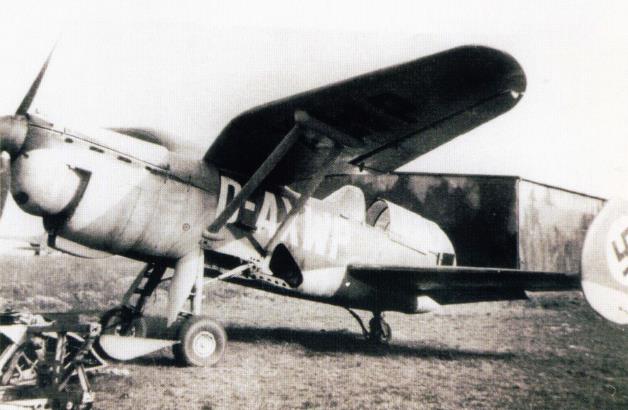The Arsenal-Delanne 10-C2 two-seat fighter designed by Maurice Delanne and built by the Arsenal de l'Aeronautique was of so-called Nenadovich biplane configuration, the tandem-mounted wings providing a continuous slot effect and offering exceptional CG travel.The fighter was of all metal stressed-skin construction, which used a sandwich technique, with a smooth dural skin welded to a corrugated sheet. Pilot and gunner sat in tandem under a single canopy at the rear of the fuselage, which was level with the rear wing, which carried twin tailplanes. This arrangement gave the gunner a clear field of fire for his planned armament of two 7.5 mm machine guns, which was to be supplemented by a 20 mm cannon firing through the propellor hub and two more machine guns in the wing. The aircraft was fitted with a retractable tailwheel undercarriage
The Arsenal-Delanne 10-C2 prototype was virtually complete at Villacoublay when German forces occupied the factory in June 1940, work on the aircraft continuing in a desultory fashion . The intended armament comprised an engine-mounted 20mm Hispano-Suiza cannon, two wing-mounted 7.5mm MAC 1934 machine guns and two further 7.5mm weapons on a flexible mounting.
1. Letectvi + Kosmonautika nr 23/93
2. Skrzydlata Polska nr 39/84
3. V. Nemecek "Vojenska letadla", d.2, Nase Vojsko, Praha, 1990
The German career of Delanne 10 C2
After the occupation troops discovered the two Delanne 10 and 20 prototypes, the RLM ("Reichsluftfahrtministerium" in
Berlin) ordered that the aircraft be restarted and then flown.
Curious about technical progress, technicians from across the Rhine could only be interested in an aerodynamic formula that was not well known to them. But, for lack of French or German documents having survived, the history of the planes
Delanne is therefore poorly known.One thing in any case is certain: their development was laborious, the French staff, that it belonged to the SAFRA or to the Arsenal, showing an excessive worry of perfection, while being quite clumsy at the same time.
This sabotage, since it must be so called, and the recommended modifications delayed the flights of at least one year. In the end the Delanne 10 did not take off until October 1941 (we do not know the date more precisely). This first flight seems to have been made by a German pilot but with the French engineer Schneider (one of Delanne's seconds) at the rear station .
Later progress was again extremely slow. In late 1942 the RLM decided to rush the things these tests the were transferred to "Deutsche Forchungsinstitut fur Segelflug "(DFS), research organization created for the study of gliders
After the departure of the Delanne 20, during the Winter 1942-1943 the 10 was brought to Germany from July 12 to 14, 1943, by the pilot Opitz. The two prototypes were then based at the DFS test site located at Airing.a few kilometers west of Salzburg.
| Type |
Two seat fighter |
| Engine |
1 Hispano-Suiza 12Ycrs |
| Dimensions |
Length 7.33 m, height 3.06 m, wingspan 10.11 m, wing area 22.5 m2 |
| Weights |
Empty , loaded 2880 kg , max. take off weight |
| Performance |
Max. speed 550 km/h, service ceiling 10000 m, time to 5000 m 6,5 min., endurance 1,5 hr |
| Type |
Werk.Nr |
Registration |
History |
|
|
D-AXWH |
After protracted delays during taxi-ing tests, and modifications to the vertical surfaces and tailwheel, the Arsenal-Delanne 10 finally flew for the first time in October 1941. The undercarriage was successfully retracted on the second flight, and some fifteen test flights were made from Villacoublay during which six hours in the air were logged. After the completion of these trials, 12 or 14 July 1943, the fighter was ferried to a German experimental centre (Oppitz) for further tests, tested at DFS led by Felix Kracht, but its subsequent history is unknown |










